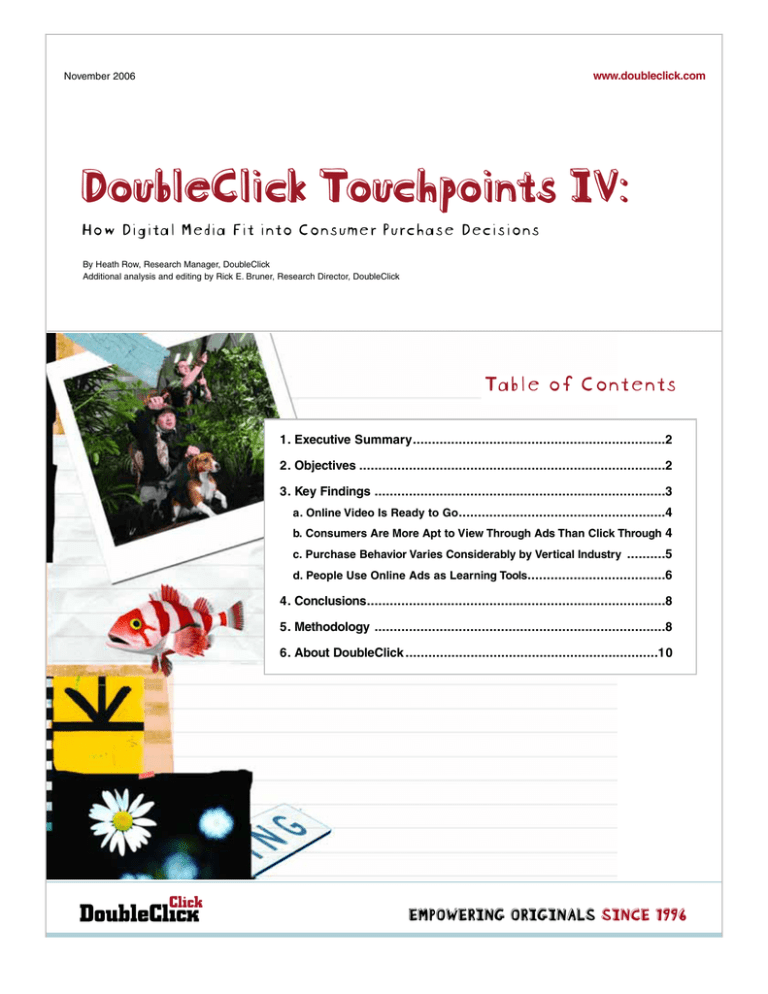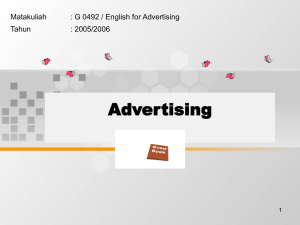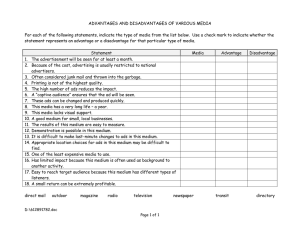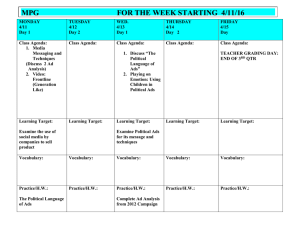
www.doubleclick.com
November 2006
DoubleClick Touchpoints IV:
How Digital Media Fit into Consumer Purchase Decisions
By Heath Row, Research Manager, DoubleClick
Additional analysis and editing by Rick E. Bruner, Research Director, DoubleClick
Table of Contents
1. Executive Summary..................................................................2
2. Objectives ................................................................................2
3. Key Findings ............................................................................3
a. Online Video Is Ready to Go ......................................................4
b. Consumers Are More Apt to View Through Ads Than Click Through 4
c. Purchase Behavior Varies Considerably by Vertical Industry ..........5
d. People Use Online Ads as Learning Tools....................................6
4. Conclusions..............................................................................8
5. Methodology ............................................................................8
6. About DoubleClick ..................................................................10
EMPOWERING ORIGINALS SINCE 1996
DoubleClick Touchpoints IV: How Digital Media Fit into Consumer Purchase Decisions
Executive Summary
For the last four years, the DoubleClick Touchpoints consumer survey has helped identify
and quantify the impact of various media and other influence factors on consumers’
purchase decision making process. The primary point is clear: The Internet – in its various
forms of websites, search engines, advertising, email, and professional and consumer
reviews – is highly influential at every stage of the process, from first awareness to final
decision making. In fact, the web influences purchase decisions – online and offline –
more than any other factor. And corporate websites have more impact than any other kind
of sites and services.
Based on feedback from our clients and the market, the DoubleClick team decided for
the fourth annual edition of the study to examine the impact of some newer online trends,
as well as to learn more about how people perceive ads. This summary of the overall
DoubleClick Touchpoints IV study will be the first of a series of research papers on those
topics based on this year’s survey of more than 6,000 U.S. Internet users.
In this paper, we examine the following key findings:
•
Consumers acknowledge that online video shows great potential for advertising.
•
Consumers say they are more likely to “view through” ads (visit advertised sites
without clicking on ads) than click through.
•
The importance of digital media in the purchase process can vary greatly by vertical.
Travel and finance purchase decisions, for example, are greatly dominated by the
Internet. For other sectors, the mix of influence is less concentrated on online channels.
•
Consumers see the value of advertising as part of the purchase consideration
phase of shopping. That may surprise some advertisers who view the key value of
ads at the top of the purchase funnel.
Objectives
Since the first DoubleClick Touchpoints consumer survey in 2002, the study has been
designed to understand what are the key influences people take into consideration when
they decide which products and services to buy (regardless of whether they buy them
online or offline).
Along with its partners ROI Research and eRewards, DoubleClick conducted an online
survey in July 2006 of 6,121 U.S. adults (18 years old and older), representative of the
population of Internet-using adults in this country. The survey asked respondents about
their purchases in the previous 12 months within the following 15 categories: automotive,
banking, credit cards, investments, mortgages and loans, air travel, hotels, rental cars,
telecommunications service plans, consumer packaged goods (personal care and household
care products), apparel, consumer electronics, housewares and furniture, movie tickets,
and prescription drugs.
© 2006 DoubleClick Inc. All Rights Reserved.
2
DoubleClick Touchpoints IV: How Digital Media Fit into Consumer Purchase Decisions
The survey then routed respondents into a set of questions specific to one of the product
categories in which they indicated they had made a purchase in the last year. The
framework of the survey was more or less the same for each vertical, allowing DoubleClick
to see how respondents answered questions differently for individual vertical industries,
as well as letting us roll up the responses to analyze common trends across all industries.
Key Stages of The Customer Purchase Funnel
Specifically, we asked participants
about the three unique phases of the
purchase process (see Figure 1):
initial awareness (“How did you first
learn about…”), information gathering
(“How did you further learn about…”)
and purchase decision (“Which of
the following most influenced…”).
At each step of the decisionmaking process, respondents were
asked to choose from approximately
15 marketing and information
factors – touchpoints – to identify
which had the biggest impact on
their awareness, consideration,
and final decision.
Figure 1
Finally, the survey prompted participants to consider all of the touchpoints in relation to each
other in order to gauge which one had the biggest impact on their purchase decision.
For more details about the structure of this study, please refer to the Methodology section at
the end of this report.
Key Findings
Last year’s DoubleClick Touchpoints III report found that Internet users cite websites above
all other factors as an influence on their purchase decisions, and that of a range of types of
websites we asked them about, corporate websites have the most influence. This year’s
research finds that that’s still true.
When analyzed across all vertical industries, 18% of respondents in the DoubleClick
Touchpoints IV survey said they were most influenced in their decision to buy a new product
or service by research they did on a website, as shown in Figure 2 (see next page). That
is greater than the number of people who cited seeing the product or service offering in a
brick-and-mortar store or word of mouth, the next two most influential factors.
As for advertising media, 3 percent of the respondents cited web advertisements as having
most influenced their decision (a number that was much greater in certain categories, such
as air travel and investment). That was roughly on par with the influence respondents
© 2006 DoubleClick Inc. All Rights Reserved.
3
DoubleClick Touchpoints IV: How Digital Media Fit into Consumer Purchase Decisions
Websites Are the Single Greatest Source of
Influence for Online Consumers When Making
Shopping Decisions
Survey Question: “Which of the following most influenced your decision to
purchase [the product/service]?”
attributed to TV, direct mail and print
ads, and significantly higher than
radio or outdoor ads or telemarketing.
Touchpoints IV uncovered several
new findings worth exploring.
Online Video Is Ready to Go
Mainstream media headlines bear
this out: Online video has arrived.
From Google’s $1.65 billion
acquisition of YouTube to the NFL’s
encouraging sports fans to create
their own video ads for the Super
Bowl, it’s clear that people are
watching video online.
Figure 2
Source: DoubleClick Touchpoints IV, 2006; all product categories; N=6,121
Watching Online Video Is Most Common
Consumer Behavior of Emerging Media
Survey Question: “Please indicate how often you use or do the following”
[Shown are those responding “Currently Do This Often” or “…Sometimes”]
Figure 3
Source: DoubleClick Touchpoints IV, 2006; all respondents, N=6,121
As shown in Figure 3, a full 43%
of Touchpoints survey respondents
reported watching video online. In
fact, this is the most popular online
activity of a list of types of emerging
media included in the survey,
equal to the number of people who
send text messages using their cell
phone. Online video is more
popular than use of portable MP3
players (38%).
Online video also has people’s
attention as an ad platform. In a
separate question, 43% of
respondents said they watch movie
trailers in online ads “all the time,”
“frequently,” or “sometimes,” and
25% click “play” on video ads that
often as well.
Consumers Are More Apt to “View Through” Ads Than Click Through
Historically, online advertisers have focused intently on click-through rates – the percentage
of ad impressions in a given campaign that impel people to click through to the advertiser’s
site. Increasingly, however, advertisers have come to recognize that a significant amount of
the effectiveness of online ads comes in the form of a “view through” – that is, when people
visit an advertised website after seeing an online ad but without having clicked on the ad,
© 2006 DoubleClick Inc. All Rights Reserved.
4
DoubleClick Touchpoints IV: How Digital Media Fit into Consumer Purchase Decisions
navigating directly to the site on their own instead. In some cases, they do so moments
after seeing the ad. In other cases, they might do so days or weeks later. (For further details
on this metric, refer to DoubleClick’s report “In-Direct Response to Digital Advertising: Best
Practices in Measuring Response Over Time; Continental Airlines Case Study.”)
The Touchpoints IV survey showed that consumers, too, recognize the view-through
phenomenon. In one question, we asked consumers how often they were likely to take a
variety of actions in response to different forms of advertising (see Figure 4). With regard
to online ads, twice as many people said they had at least sometimes “notice a web ad,
do not click but visit the advertised site later” (61%) compared to those who said they click
on banner ads at least sometimes (30%). This 2:1 ratio in favor of view-through over clickthrough is consistent with what
DoubleClick sees from actual
Customers Are More Likely to Visit Stores or
Websites on Their Own After Seeing Online
campaign performance metrics
Ads Than They Are Likely to Click
with many of our clients.
Survey Question: “Please indicate how often you take the following actions
with regard to advertising” [Shown are those responding “All the time”,
“Frequently” or “Sometimes”]
Figure 4
Source: DoubleClick Touchpoints IV, 2006; all respondents, N=6,121
Strikingly, an even larger number
(67%) said that they sometimes visit
a physical store after seeing web ads.
What is clear from this analysis is
that, at least in the perception of
consumers, the impact of web ads is
more pronounced in their indirect,
brand-oriented effect on behaviors
rather than in the direct click-through
action that so many advertisers
still use as the primary way to value
the results of online advertising.
Purchase Behavior Varies Considerably by Vertical Industry
Some characteristics of the role that the Internet and other touchpoints play in purchase
decisions is consistent across most verticals. For example, websites are a vital factor for
awareness and consideration for most categories, as is word of mouth. But to a large extent,
the purchase funnel looks substantially different when comparing various product categories.
In hard asset categories such as home products and apparel, physical retail stores remain
the most important touchpoint for all three stages of the purchase decision making process.
In more service-oriented verticals, such as investments and telecommunications, word of
mouth was particularly important, being the top response in the first-learning and finaldecision stages.
For air travel, hotels, and rental cars, the web overwhelmingly dominates as the most
influential factor for decision making, as shown for airfares in Figure 5 (see next page). For
movie tickets, the web didn’t even make the top five responses at any stage of influence.
© 2006 DoubleClick Inc. All Rights Reserved.
5
DoubleClick Touchpoints IV: How Digital Media Fit into Consumer Purchase Decisions
Websites by Far Dominate Purchase
Decisions for Airline Tickets; Web Ads More
Influential Than Other Ad Types
Survey Question: “Which of the following most influenced your decision to
make this travel purchase?”
Figure 5
Source: DoubleClick Touchpoints IV, 2006; airfare ticket buyers, N=425
Movie Goers Most Influenced by Ads on TV
and in Theaters, Word of Mouth and Reviews
Survey Question: “Which of the following most influenced your decision to
see this movie?”
Instead, TV ads play an extremely
important role in promoting movie
releases, as shown in Figure 6.
These data may be slightly
misleading if one were to conclude
from them that web advertisers is
less effective for categories such
as housewares, consumer
packaged goods or apparel, where
few respondents cited web ads as
a major factor in their decision.
What is just as likely is that
consumers are less inclined to cite
web ads as a part of their decision
in these categories precisely
because advertisers in those
categories are investing less in
web marketing, so consumers have
less chance to see ads online for
those products.
People Use Online Ads More for
Learning About Products Than
Discovery
A close examination of the data
reveals that consumers are more
likely to value the role of certain
types of ads – particularly forms
of online media – as part of the
information-gathering and
consideration phase of the shopping
decision cycle rather than as a
source of initial awareness about
those products. This may surprise
Figure 6 Source: DoubleClick Touchpoints IV, 2006; movie ticket buyers, N=463
some advertisers, who may be
inclined to understand the value of ads as primarily an awareness vehicle instead of an
information tool during the consideration phase of shopping.
For example, when examined across all industries, consumers valued the role of word of
mouth almost equally as a source of first awareness and further learning: 12% and 13%
respectively. Similarly, 14% said they first learned about a product or service when they
“saw it in a store,” compared to 18% who cited “saw it in a store” as how they further
learned about it.
© 2006 DoubleClick Inc. All Rights Reserved.
6
DoubleClick Touchpoints IV: How Digital Media Fit into Consumer Purchase Decisions
Yet, 8% of respondents cited web ads as a source of further learning compared to only 4%
that cited web ads as a source of first learning. That means that respondents were twice
as likely to consider the value of web ads being a means of product research compared to
initial awareness. Similarly, respondents were much more likely to perceive the value of
radio ads, search engines, and websites in the purchase funnel as being a tool for product
education rather than initial awareness
Consumers Are More Likely to Value Some
Ad Types as Sources of Further Learning
Than for Initial Awareness
Survey Question: “Thinking about your most recent purchase, how did you
first hear… / how did you further learn about this product/service?”
Figure 7 shows how the leading
touchpoints rank in terms of their
likelihood to be valued more in the
“further learning” phase of
shopping as opposed to “first
learning.” The touchpoints in this
chart are ordered from left to right
by those that show the greatest
proportional change in their
position in the purchase funnel
from first learned to further learned.
For example, 0.75% of
respondents cited “radio ads” as
how they first learned of a product
compared to 3% who cited them
Figure 7 Source: DoubleClick Touchpoints IV, 2006; all respondents, N=6,121
as where they went for “further
learning,” meaning people were
four times more likely to consider the value of radio ads as a means of learning than as a
source of discovery. Likewise, people were almost four times more likely to cite the value
of search as that of further learning than first awareness; three times as likely to say so for
sales people, and more than twice as likely for websites and web ads.
On the flip side, the touchpoints seeing a product in the store, TV ads, word of mouth, and
direct mail were viewed by respondents nearly equally as sources of first learning and
further learning.
This phenomenon is especially pronounced in specific vertical industries. In the air travel,
hotels, and rental cars categories, between 18-20% of respondents indicated that they
turned to web ads for further information. In each of those categories, web ads were the
fourth most popular touchpoint for further learning. Similarly, in the investments category,
web ads were the third most popular source of further information, with 12% of respondents
selecting it as an option. And in the credit cards category, web ads also came in third,
with 9% of respondents citing them for that.
© 2006 DoubleClick Inc. All Rights Reserved.
7
DoubleClick Touchpoints IV: How Digital Media Fit into Consumer Purchase Decisions
Conclusions
•
Online video is as hot with consumers as it is with advertisers. Of a long list of
emerging media we asked them if they were using, watching video online was cited
most often, with 43% of consumers saying they did so today. With the widespread
adoption of broadband Internet access (more than 80% of U.S. Internet users in
2006, according to eMarketer), publishers should provide as much quality streaming
video content as they can to meet the growing demand from consumers and
advertisers alike.
•
Advertisers should optimize their online advertising campaigns around the viewthrough metric. Consumers’ perceptions of the impact of online advertising validate
what many see in the results of their online campaigns: More consumers react to
ads by visiting the advertised websites directly rather than clicking on an ad.
•
Categories that have heavily invested in online marketing, including travel, finance and
telecommunications, have seen the medium’s capacity to influence customers
demonstrated powerfully. These categories were among those first to invest significantly
in online. Before marketers in other categories should assume, based on the results of
this survey or other third-party data, that online ads do not work as well for their
markets, those companies should first test investment levels online that are adequate to
measure web ads in comparison to investments in other media. It’s likely that
consumers are citing the influence of web ads less in other sectors only because there
are few web ads to be seen in those sectors because those marketers have not yet
invested adequately in the channel for it to demonstrate its relative benefit in the mix.
•
People use web ads as learning tools. The value of ads in those cases might be
further along the purchase decision making process than advertisers traditionally
believe. In some cases, the primary purpose of ads should not be to brand or
increase awareness, but to inform or offer additional guidance and advice that could
lead to a purchase decision. Advertisers should bear this in mind when creating and
planning campaigns. For example, advertisers might target media buys based on
where consumers are likely to be “in-market” for relevant products, as well as using
features in ad creative, such as rich media and video, to highlight product benefits
and offer online demonstrations.
Methodology
Touchpoints IV was fielded in July 2006. ROI Research helped DoubleClick manage the
research project. Survey respondents were solicited from eReward’s opt-in panel of
research participants, which is normalized to reflect the Internet-using population in the
U.S. A total of 6,121 adult (18 years old and older) Internet users completed the survey.
More than 400 respondents completed the survey for each of the 15 vertical industry
sectors (except for hotels [391] and car rentals [302]). Results for the total sample of 6,121
© 2006 DoubleClick Inc. All Rights Reserved.
8
DoubleClick Touchpoints IV: How Digital Media Fit into Consumer Purchase Decisions
adults should be representative for the total U.S. population of Internet users to a margin of
error of 1.2% at a confidence level of 95%; the smaller industry segments of 400-plus
respondents should be representative to a margin of error of 4.9%
Report Contributors
Writing: Heath Row, Research Manager
Editing and analysis: Rick E. Bruner, Research Director
Data analysis: Jai Singh, Research Manager
Research project management: Ed Snider, ROI Research
Other Recent DoubleClick Research Reports:
Best Practices for Optimizing Web Advertising Effectiveness
http://www.doubleclick.com/us/knowledge_central/documents/research/dc_bpwp_0605.asp
The Decade in Online Advertising
http://www.doubleclick.com/us/knowledge_central/documents/research/dc_decaderinonline_0504.asp
DoubleClick Performics 50 Search Trend Report Q2 2006
http://www.doubleclick.com/us/knowledge_central/documents/trend_reports/dc_search_q206.asp
Search Before the Purchase: Understanding Buyer Search Activity as It Builds to Online Purchase
http://www.doubleclick.com/us/knowledge_central/documents/research/searchpurchase_0502.asp
For additional reports and studies, go to http://www.doubleclick.com/knowledge
© 2006 DoubleClick Inc. All Rights Reserved.
9
DoubleClick Touchpoints IV: How Digital Media Fit into Consumer Purchase Decisions
About DoubleClick
DoubleClick provides technology and services that empower marketers, agencies and
web publishers to work together successfully and profit from their digital marketing
investments. Our focus on innovation, reliability, and insight enables clients to improve
productivity and results.
Since 1996, DoubleClick has empowered the original thinkers and leaders in the digital
advertising industry to deliver on the promise of the rich possibilities of our medium. Today,
the company’s DART and Performics divisions power the online advertising marketplace.
Tomorrow, we will continue to enable clients to profit from opportunities across all digital
advertising channels as consumers worldwide embrace them.
DoubleClick has global headquarters in New York City and maintains 15 offices around the
world to serve its more than 1,500 clients. See below for a list of our main offices.
NEW YORK
HEADQUARTERS
111 Eighth Avenue
10th Floor
New York, NY 10011
Tel: 212-683-0001
CHICAGO
PERFORMICS
180 North LaSalle Street
Suite 1100
Chicago IL 60601
Tel: 312-739-0222
SAN FRANCISCO
123 Townsend Street
4th Floor
San Francisco, CA 94107
Tel: 415-276-5300
FRANCE
PARIS REGION
Immeuble Oméga A
(6th Floor)
9, Place Marie-Jeanne Bassot
92300 Levallois-Perrett
Tel: +33 (0)1 49 68 83 83
GERMANY - DÜSSELDORF
Graf-Adolf-Platz 15
40213 Düsseldorf
Tel: +49 (0) 211 50 864 0
GERMANY- FRANKFURT
Unterlindau 58 / 2nd floor
60323 Frankfurt
Germany
Tel: +49 (0) 69 90 55 0
GERMANY - HAMBURG
Falkenried/Straßenbahnring 4
20251 Hamburg
Tel: +49 (0)40 41 406-18
IRELAND
The Plaza
East Point Business Park
Clontarf, Dublin 3,
Republic of Ireland
Tel: +353 1 246 0400
SPAIN - MADRID
Paseo de la Castellana 164
(Entreplanta)
28046 Madrid
Tel: +34 (0)91 788 5765
UNITED KINGDOM
Compass House, 4th Floor
22 Redan Place
London, W2 4SA
Tel: +44 (0)800 912 1344
UNITED KINGDOM
Corrie House
Virginia Water
Surrey GU25 4JH
Tel: +44 (0) 13 4443 0372
AUSTRALIA
Suite 19, Level 1
88 Cumberland Street
The Rocks,
Sydney, NSW 2000
Australia
Tel: +61-2-8247-3700
CHINA - BEIJING
TECHSOLUTIONS (Beijing)
Co. Ltd.
Room 701A, 7th Floor,
Fullink Plaza
No. 18 Chao Yang Men Wai
Chao Yang District
Beijing 100020
China
Tel: +86 10 6588 4765
HONG KONG
TECHSOLUTIONS
4212-13 RBS Tower, Times Square
Causeway Bay, Hong Kong
Tel: +852 3760 1888
SHANGHAI
4735, Hongkong New Word Tower
300 Huaihai Zhong Road
Shanghai 200041
Tel: +86 21 5116 2952
© 2006 DoubleClick Inc. All Rights Reserved.
10



